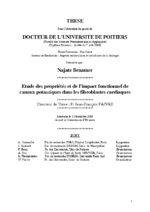Benamer Najate
Étude des propriétés et de l'impact fonctionnel de canaux potassiques dans les fibroblastes cardiaques
frConsulter le texte intégral de la thèse (format PDF)

Résumé
Français
Étude des propriétés et de l'impact fonctionnel de canaux potassiques dans les fibroblastes cardiaques
Dans le coeur, les fibroblastes représentent la population cellulaire majoritaire en nombre. Ces dernières années, des études ont révélé un rôle important de ces cellules dans le fonctionnement normal et pathologique du coeur. Les fibroblastes sont physiologiquement la source de nombreux facteurs autocrines et paracrines. Ils sont également à la base du renouvellement de la matrice extra-cellulaire (MEC). En réponse à un stress pathologique, ils peuvent subir un processus de différenciation en myofibroblastes et une altération de leurs propriétés et de leur fonction à l'origine d'un dysfonctionnement cardiaque. Bien que les fibroblastes soient considérés comme des cellules non excitables, des études ont révélé ces dernières années l'expression fonctionnelle de différents canaux ioniques sur leur membrane. L'objectif de ma thèse a été d'une part de caractériser au niveau moléculaire et fonctionnel de nouvelles conductances dans les fibroblastes cardiaques et d'autre part d'évaluer leur impact sur les propriétés fonctionnelles de ces cellules. Un criblage par PCR à haut rendement a permis de révéler l'expression d'un ensemble de gènes codant des sous-unités canalaires dans les fibroblastes cardiaques. Parmi ces gènes, ceux codant les sous-unités SUR2 et Kir6.1 ont le niveau d'expression le plus élevé. L'association des unités SUR2 et Kir6.1 étant connue pour former un canal potassique, nous avons focalisé notre intérêt sur ces deux sous-unités. Des analyses par western-blot ont montré une augmentation progressive de l'expression des unités SUR2 et Kir6.1 au cours de la différenciation des fibroblastes en myofibroblastes...
Mots-clés libres : Prolifération, Fibroblastes cardiaques, SUR2/Kir6.1, Sphingosine-1-phosphate, Migration, IL-6, Collagène.
- Cellules -- Prolifération
- Canaux à potassium
- Collagène
- Interleukine 6
English
Molecular and functional characterization of a new potassium conductance in mouse ventricular fibroblasts
In the heart, fibroblasts represent the major cell type. They contribute to the production of the extracellular matrix. Cardiac remodelling during pathological injury is associated with differenciation of fibroblasts into myofibroblasts. The aim of this study was to characterize at molecular and functional levels a new K conductance in these cells. Among K channel transcripts which were screened by high-throughput real-time PCR, SUR2 and Kir6.1 mRNAs were found to be the most abundant. Western-blots showed that SUR2 and Kir6.1 protein expression levels increased with culture duration as fibroblasts differenciated into myofibroblasts. In the inside-out configuration of the patch-clamp technique, SUR2/Kir6.1 K channels were recorded and showed insensitivity to ATP, inhibition by glibenclamide and activation by pinacidil and UDP. These properties are similar to those reported by Yamada et al (1998) for the SUR2/Kir6.1 molecular signature. In the whole cell configuration, these channels gave rise to a macroscopic glibenclamide-sensitive current which was activated by pinacidil and which amplitude increased with culture duration. This current was also activated by the endogenous sphingolipid sphingosine-1-phosphate (S1P) at the nM concentration range. The activation of this current was found to stimulate cell proliferation and to decrease IL-6 and collagen secretion. All these functional effects occurred for culture duration greater than 5 days. In conclusion this work shows for the first time the presence of a glibenclamide-sensitive current which appears during differenciation of fibroblasts into myofibroblasts. This SUR2/Kir6.1 current, which may be activated...
Keywords : Cardiac fibroblasts, Sphingosine-1-phosphate, K channel, Proliferation, Migration, IL-6, Collagen, Secretion.
Notice
- Diplôme :
- Doctorat d'Université
- Établissement de soutenance :
- Université de Poitiers
- UFR, institut ou école :
- UFR des sciences fondamentales et appliquées (SFA)
- Laboratoire :
- Institut de physiologie et biologie cellulaires - IPBC
- Domaine de recherche :
- Aspects moléculaires et cellulaires de la biologie
- Directeur(s) de thèse :
- Jean-François Faivre
- Date de soutenance :
- 02 décembre 2009
- Président du jury :
- Frédéric Becq
- Rapporteurs :
- Alain Coulombe, Sylvain Richard
- Membres du jury :
- Jean-François Faivre, Rodolphe Fischmeister, Antoine Bril
Menu :
-
-
À propos d'UPthèses
-
Voir aussi
Annexe :
-
Une question ?
Avec le service Ubib.fr, posez votre question par chat à un bibliothécaire dans la fenêtre ci-dessous :
ou par messagerie électronique 7j/7 - 24h/24h, une réponse vous sera adressée sous 48h.
Accédez au formulaire...
Université de Poitiers - 15, rue de l'Hôtel Dieu - 86034 POITIERS Cedex - France - Tél : (33) (0)5 49 45 30 00 - Fax : (33) (0)5 49 45 30 50
these@support.univ-poitiers.fr -
Crédits et mentions légales
